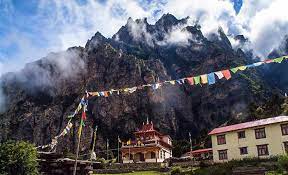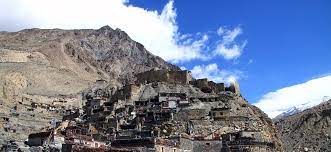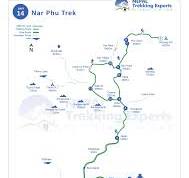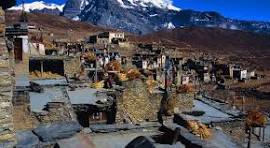Description
Overview :
A less popular and more isolated trekking route in Nepal's Annapurna region is the Nar Phu Valley Trek. The route leads you north of the Annapurna Circuit via the beautiful valleys of Nar and Phu. Trekking the Himalayas offers a unique opportunity to discover pristine and rarely traveled regions, presenting breath-taking views of high peaks, historic monasteries, diverse topography, and an abundance of cultural heritage.
The Nar Phu Valley Trek is well-known for offering an experience that is off the typical route and enables hikers to really engage with the real culture and way of life of the local ethnic people. Buddhist temples, traditional Tibetan-influenced villages, and amazing panoramas of snow-capped peaks like Dhaulagiri, Annapurna, and Manaslu greet you.
It normally takes 16 to 21 days to complete the journey, depending on the schedule and route that are selected. Because the path crosses high mountain passes like the Thorong La Pass and the Kang La Pass, which can be difficult due to their rugged terrain and high elevations, it is imperative that hikers be well-prepared and physically healthy.
Due to the trail's isolated area and low supply of facilities, it is recommended to get the required permits and hire a knowledgeable guide or porter before starting the Nar Phu Valley Trek. It's also important to keep up with local weather reports and prepare appropriately for the range of temperatures and terrain.
Overall, for those seeking to see the natural beauty of the Nepalese Himalayas, the Nar Phu Valley Trek offers a genuinely immersive and fulfilling experience.
Major Highlights :
- Remote landscapes: This trek serves the Himalayas' pure beauty, complete with amazing views, deep canyons, and vast mountain views.
- Nar and Phu villages: The traditional Tibetan-influenced villages of Nar and Phu offers a glimpse of the distinctive way of life, culture, and architecture of the local ethnic populations.
- Holy places : Historic Buddhist temples and gompas that are a reflection of the region's rich cultural legacy and spiritual traditions can be viewed during this journey.
- High mountain passes: Boost the thrill by trekking to high-altitude mountain passes like Thorong La Pass and Kang La Pass, which provide amazing views of the surrounding peaks and valleys.
- Beautiful mountain scenery: Enjoy the amazing comprehensive views of some of the highest peaks in the world, including as Dhaulagiri, Annapurna, and Manaslu.
- Rich flora and fauna: Along the trek, you'll come across a diversity of plant types that flourish in the high altitude and rare creatures.
- Cultural immersion: Trekkers get to understand the local people and learn more about their traditions, customs, and way of life via cultural exchanges.
Detailed Itinerary
Explore our comprehensive day-by-day itinerary to discover the
highlights and activities planned for each day of your trek.
Day 1 Kathmandu to Besisahar to Jagat
Following an enjoyable breakfast in the early hours of the morning, we set off on a scenic 190-kilometer (6-7 hour) trip from Kathmandu to Besisahar. The lovely Trishuli River is followed by the local bus as it leaves the valley. As the trip goes on, you'll see beautiful views of mountains, including the peaks of Ganesh and Manaslu, terraced farms, and traditional villages.
We eventually go north to Besisahar then take the main route that leads to Pokhara. We continue driving through rice fields after Besisahar until we arrive at Jagat, a village built in the Tibetan style.
Day 2 Jagat to Dharapani
After breakfast in the early morning, we hike upward on a route that leads to Chame. After that, you'll go across a suspension bridge and descend a steep, rocky road to Tal Village. Tal offers beautiful waterfalls for you to enjoy. We move on, across a suspension bridge to go to lower Dharapani after taking in Tal's splendor. We will spend the night in upper Dharapani, which is a short distance away.
Day 3 Dharapani to koto
It will take you four or five hours to reach Nar Phu Valley. To get to Bargarchhap, the path travels through woods of pine and fir, a number of monasteries, and traditional settlements. Bargarchhap has beautiful views of Manaslu, Annapurna II, and other peaks. The journey goes on through pine trees till it comes to Koto, an ethnically-rich Gurung village.
Day 4 Koto to Meta
We travel down the banks of the Soti Khola through beautiful pine forests, through several suspension bridges and tumbling waterfalls, finally arriving in Dharamshala in approximately five hours after registering our restricted area permits at the police control station at Koto.
The views get wider and the forests get thinner after Dharamshala. We go through the jungle for another hour and a half, climbing sharply to reach Meta village on the Tibetan Plateau. From here, the views of Lamjung Himal and Annapurna II are stunning.
Day 5 Meta to Phu Gaon
The pathway consistently rises and lowers, and you'll eventually arrive in Chyaku by way of a suspension bridge. Before you reach Kyang, you will begin to get amazing views of Annapurna as you continue your ascent. Kyang offers breathtaking views of Annapurna II and Pisang Peak. Submarine rocks and maybe a few tents will be left behind as you continue up a rocky route beyond the Phu Khola to Phu gate, which is the entrance to Phu Village.
Famous for their unique blue sheep, diverse cultures, and distinctive religious customs are the villages of Nar and Phu. We will definitely make time to visit Tashi Lhakhang Monastery while we are in Phu Village. Magnificent views of many Himalayan mountains, including Himlung Himal, can also be seen from Phu Village.
Day 6 Phu Gaon to Nar
After leaving Phu Gaon, we go over two high mountains on route to Nar village: Phu Pass (5,050m) and Nar Pass (5,400m). The path crosses many suspension bridges over streams, the most notable of which being the Mahendra Pul. You may enjoy views of Pisang Peaks and several more from the trek.
Day 7 Acclimatization and preparation at Nar
We have one day to acclimate at Nar. This is a perfect chance to relax and learn about the people, customs, and culture of the Nar village. There are many monasteries and chortens in Nar village. Almost every family at Nar has a child studying Buddhism, which is likely to surprise you.
Day 8 Nar to Ngawal
From Nar, we take an enjoyable trail that weaves through yak pastures and climbs through the lateral moraine of Temdenzon Khola, offering amazing views of the west ridge of the Pisang Peak. After that, the trek will lead you to Jhombu Kharka, which is the base of Kang La Pass, also referred to as Kang la Phedi.
We will gradually climb up to Kang La Pass from Kang La Phedi. Although the terrain is steep, it is not too challenging. We expect that crossing the pass will take around two hours. You can get incredible views of Tilicho Peak, Gangapurna, and Annapurna II from the Kang La Pass pass. After that, it will take us three more hours of hiking to get to Ngawal Village, where we will spend the night.
Day 9 Nagwal to Manang
We leave from Ngwal and move toward the Marsyangdi River's banks to Manang. With sights of the Annapurna and Tilicho Peak ranges, you will pass through a number of forests and villages, including Braga and Paugh, as you go. After arriving in Mungli, our route re-joins the main Annapurna paths. We continue walking till we get to Manang, which is our today's destination.
Day 10 Manang to Yak Kharka
After leaving Manang, we go northwest through the Marshyangdi Valley to Jar Sang Khola Valley, crossing a stream to arrive at Tenki village. The route gradually climbs as it passes through a few juniper trees and farms before arriving at Gunsan, a small village. In Gunsan, homes are constructed with flat mud roofs. You may come across yaks and horses roaming in the neighboring meadows because the people grow them. Once we pass a little river on a wooden bridge, we climb the breathtaking slopes to Yak Kharka, which is an open, serene meadow.
Day 11 Yak Kharka to Thorong Phedi
We are headed to Thorong Phedi, the base of Thorong La Pass, today. You will ascend to a hill from Yak Kharka, go down, and cross the Marsyangdi river on a wooden bridge. We follow a small path across a slope and descend to Thorongh Phedi after continuing on the mountain way.
Day 12 Thorong Phedi to Muktinath
As the highest point of our journey and one of the highest crossings in the globe, we will cross Thorong La Pass today. The sights from the Thorong La Pass are worth the challenging trek, freezing temperatures and high altitude that we strain ourselves to endure. You will be faced with a view of the magnificent Himalayan peaks that reach into Tibet to the north. You can see many Annapurna ranges in the back. After that, we'll go down to Muktinath. It will take three to four hours to make the very steep descent to Muktinath.
For Buddhists and Hindus alike, Muktinath is a holy place. In Tibetan, it is known by the Buddhists as Chumig Gyatsa, or "Hundred Waters." Indeed, there are 108 water sprouts on the grounds of the Muktinath temple along with an everlasting flame.
Day 13 Muktinath to Jomsom
First, we descend to the town of Ekle Bhatti. After that, we go to the villages of Jharkot and Khingar, where you may see several stunning monasteries. We'll walk past Kagbeni and down the Kali Gandaki River's banks to Jomsom. Along the entire trek, there is an amazing view of Dhaulagiri and Nilgiri.
Day 14 Jomsom to Tatopani
We take a local bus to Tatopani from Jomsom. This bumpy bus trip will take you from the dry high elevation scenery to the lowlands with lush jungles and farmlands, passing past some of the world's deepest gorges.
The Kali Gandaki River, which divides Dhaulagiri, the seventh-highest mountain in the world, from Annapurna, the tenth-highest summit in the world, is another breathtaking sight to behold. Tatopani is well-known for its organic thermal springs. If your muscles are too tight, you may relax by taking a plunge in the hot springs nearby.
Day 15 Tatopani to Pokhara
We leave Tatopani early in the morning and go through Beni Bazaar on our seven-hour bus or jeep trip to Pokhara. Nepal's tourism capital is Pokhara. You may appreciate all that beautiful city has to offer while having fun here. Pokhara offers a plethora of experiences.



